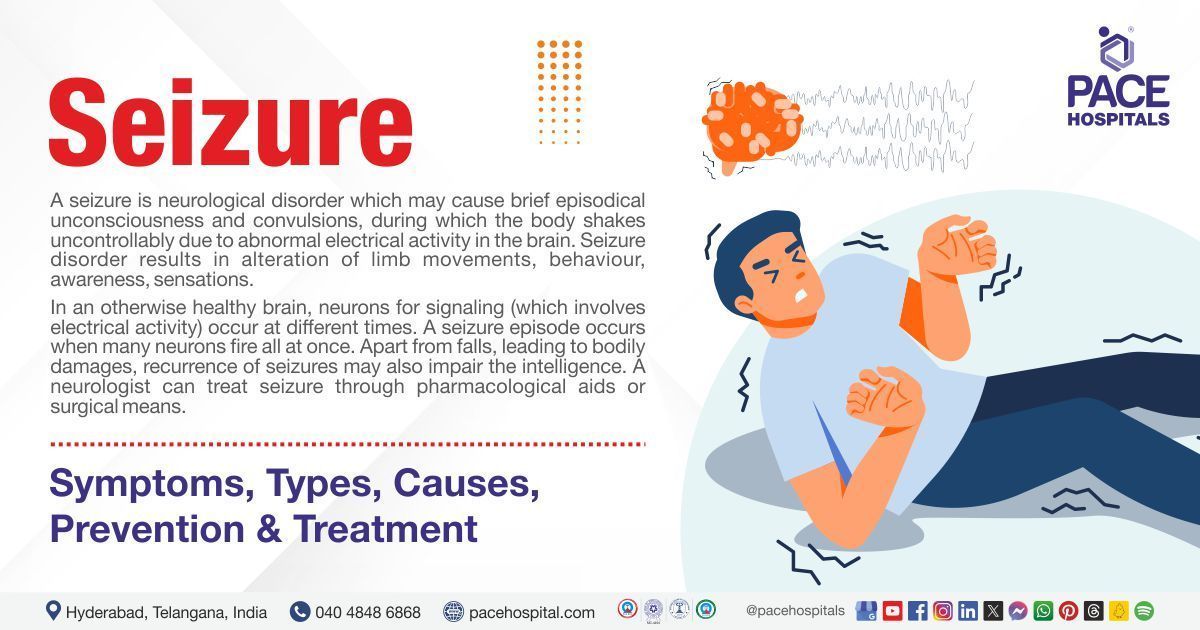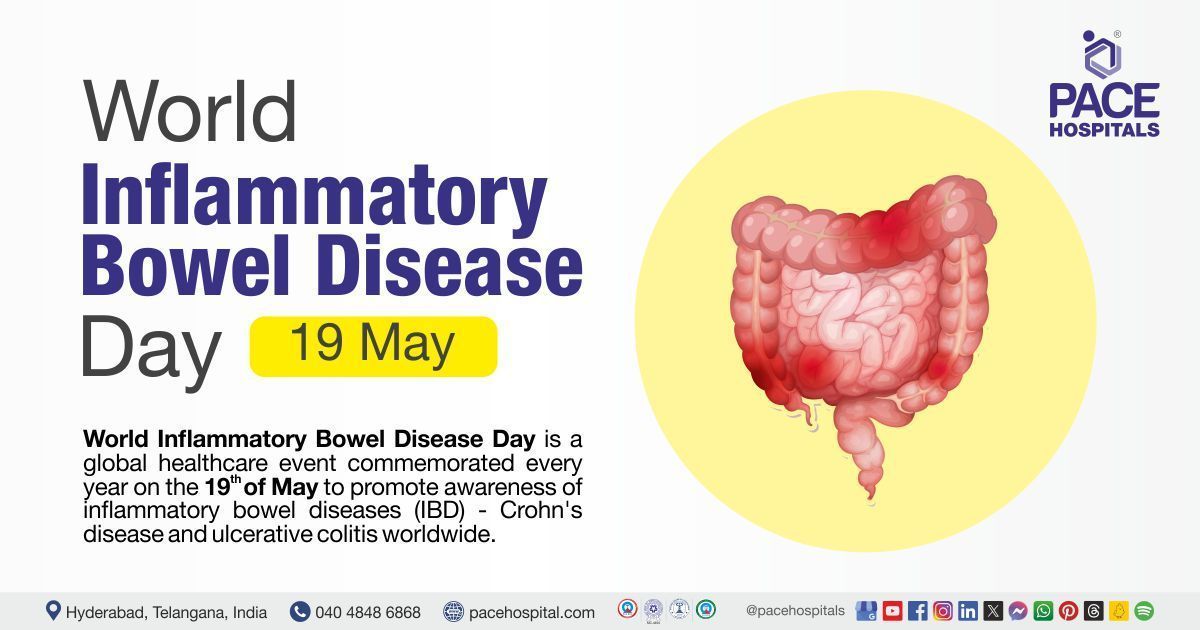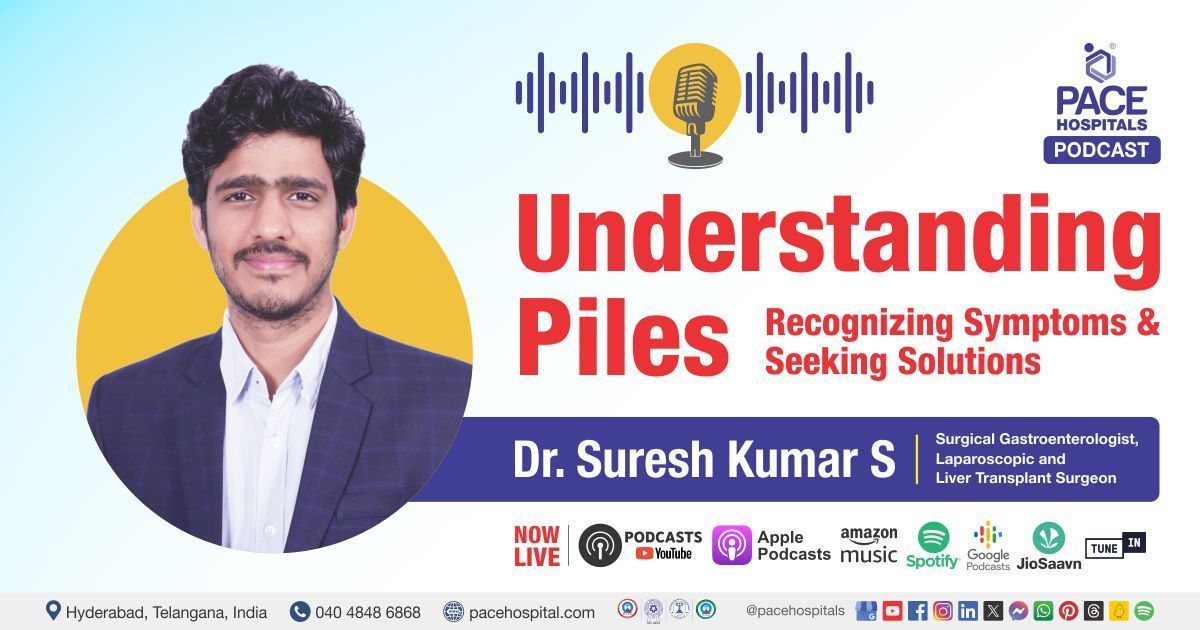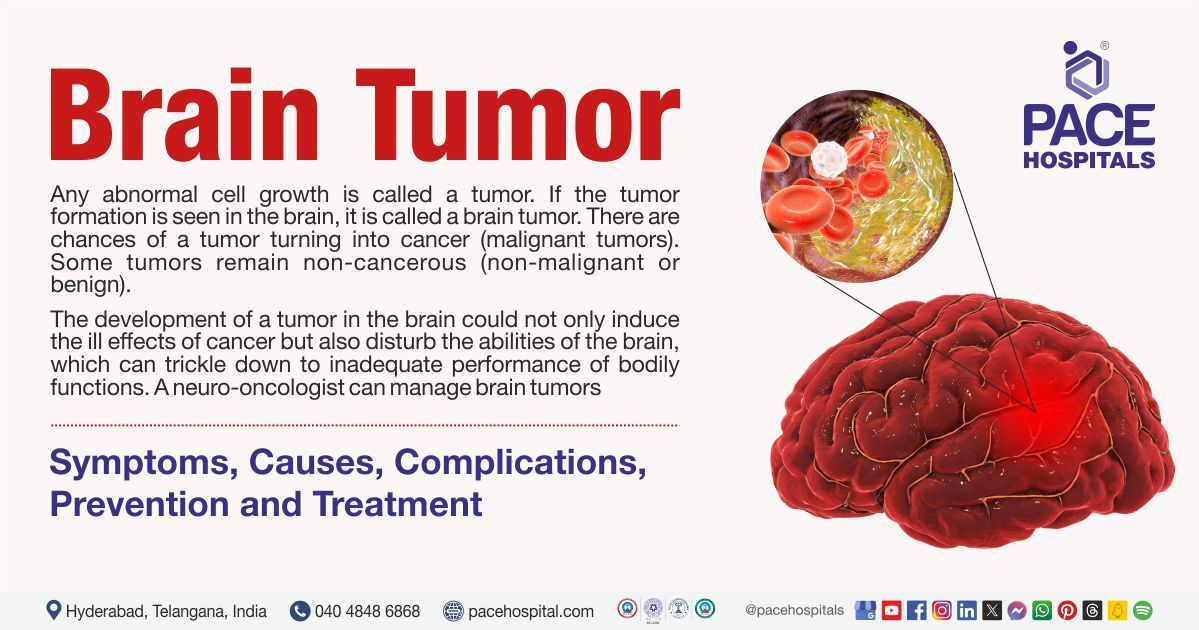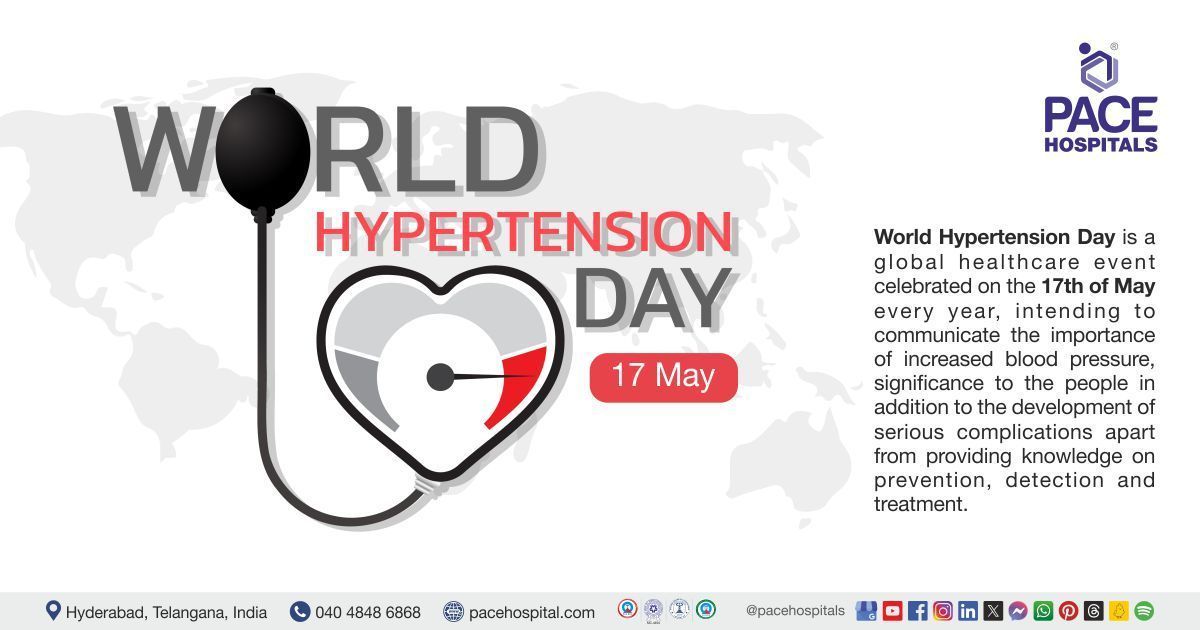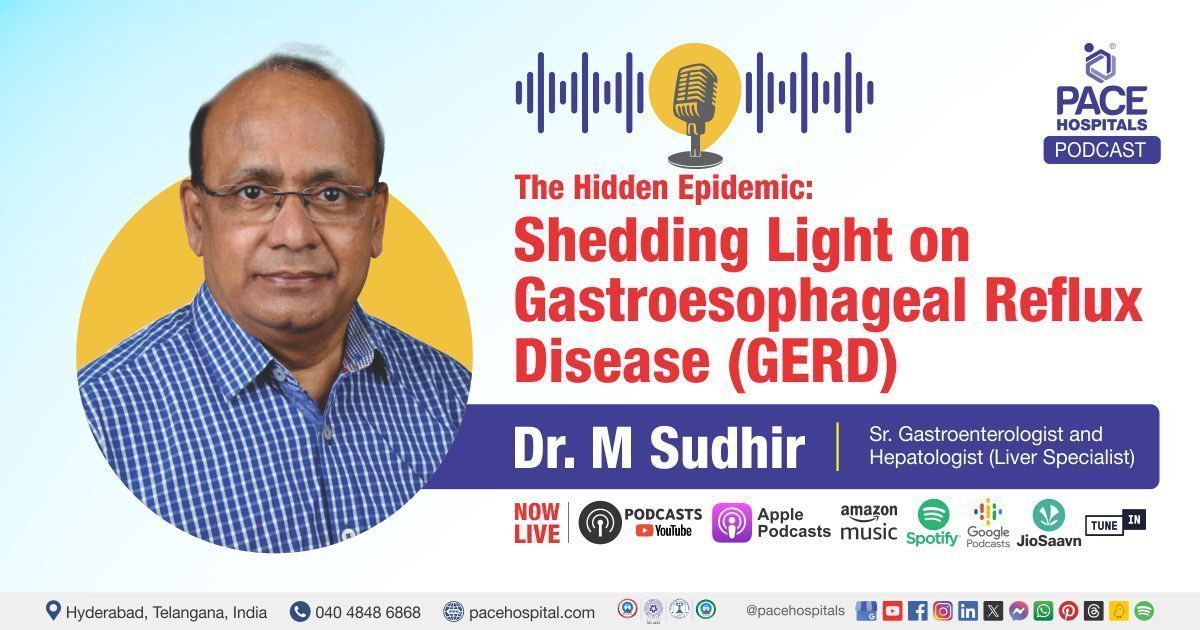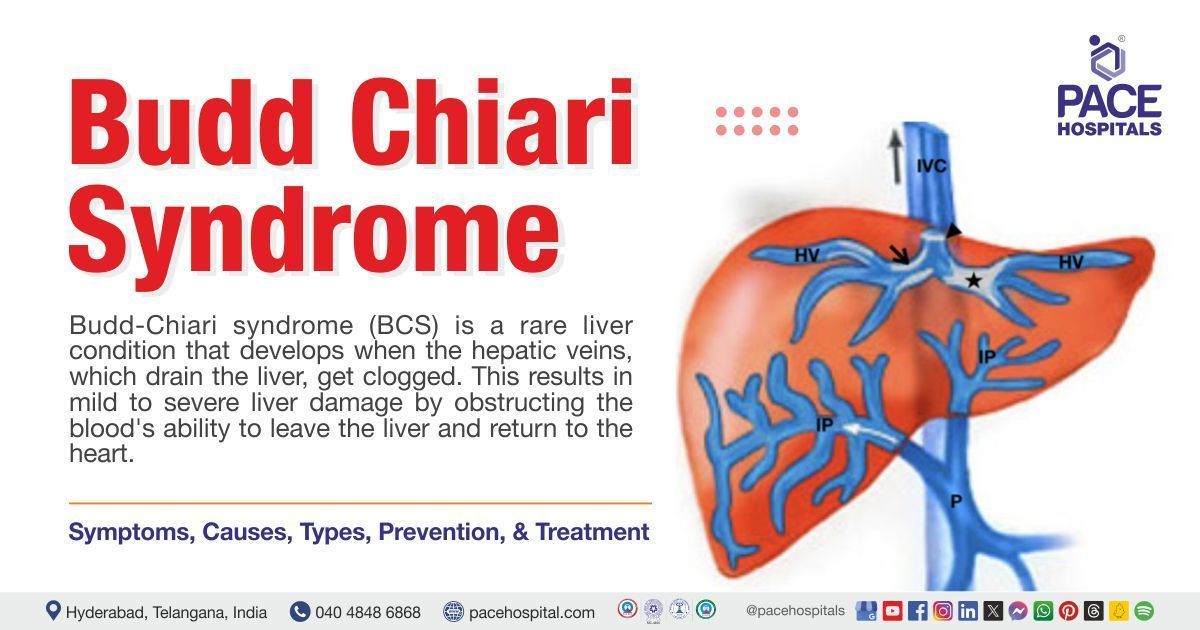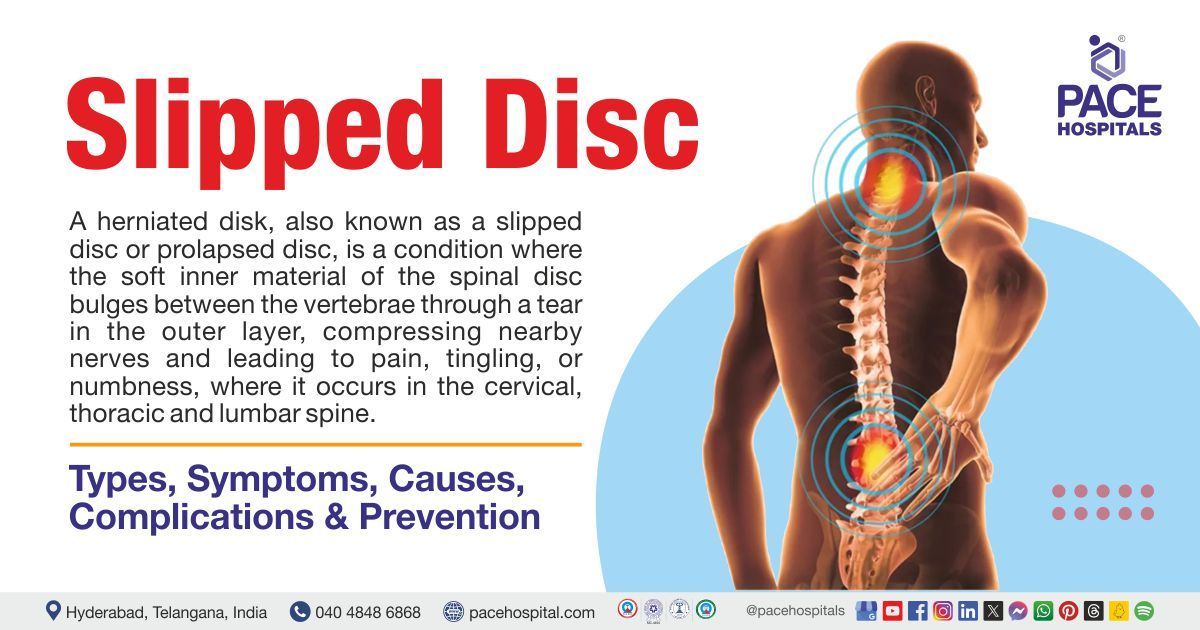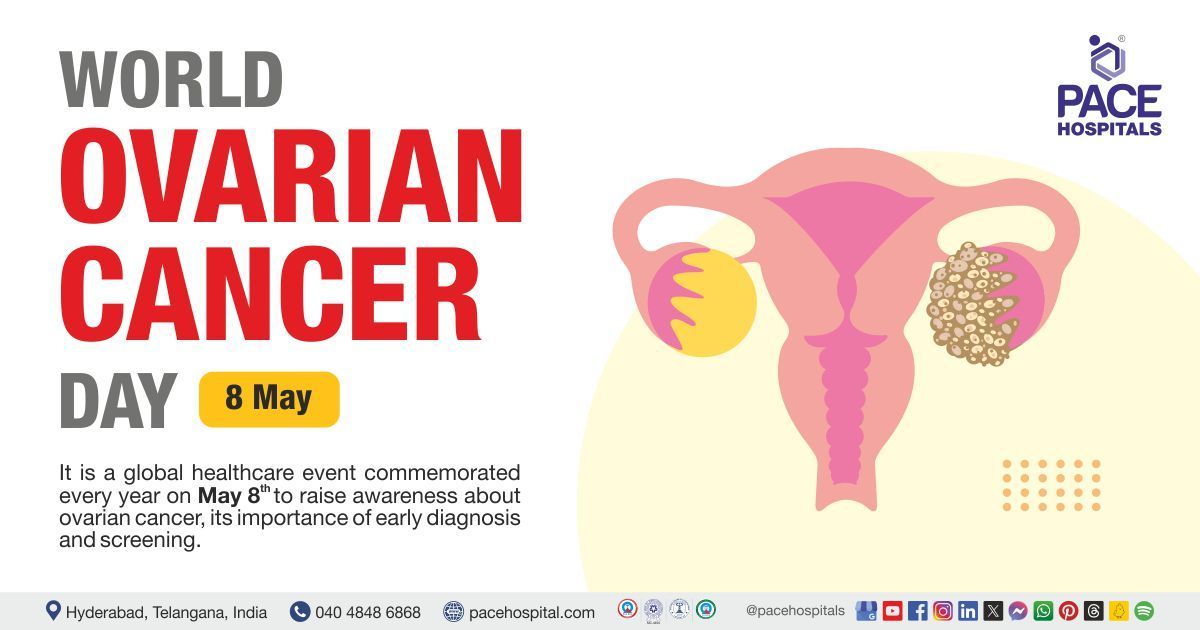Seizure Disorder – Types, Symptoms, Causes, Complications and Prevention
Seizure definition
A seizure is neurological disorder which may cause brief episodical unconsciousness and convulsions, during which the body shakes uncontrollably due to abnormal electrical activity in the brain. Seizure disorder is a paroxysmal change of neurologic function caused by brain neurons' excessive, hypersynchronous discharge.
Seizure disorder results in alteration of limb movements, behaviour, awareness, sensations. In an otherwise healthy brain, neurons for signalling (which involves electrical activity) occur at different times. A seizure episode occurs when many neurons fire all at once. Apart from falls, leading to bodily damages, recurrence of seizures may also impair the intelligence. A neurologist can treat seizure through pharmacological aids or surgical means.
Seizure meaning
A seizure is derived from the Latin word “sacire", meaning to take possession of the clinical condition of an abnormal, excessive, hypersynchronous discharge of a population of cortical neurons.
Prevalence of seizure worldwide
Seizures can occur, from less than one per year to several per day. Worldwide, nearly up to 10% of people during their lifetime have only one seizure; hence, a seizure does not signify epilepsy.
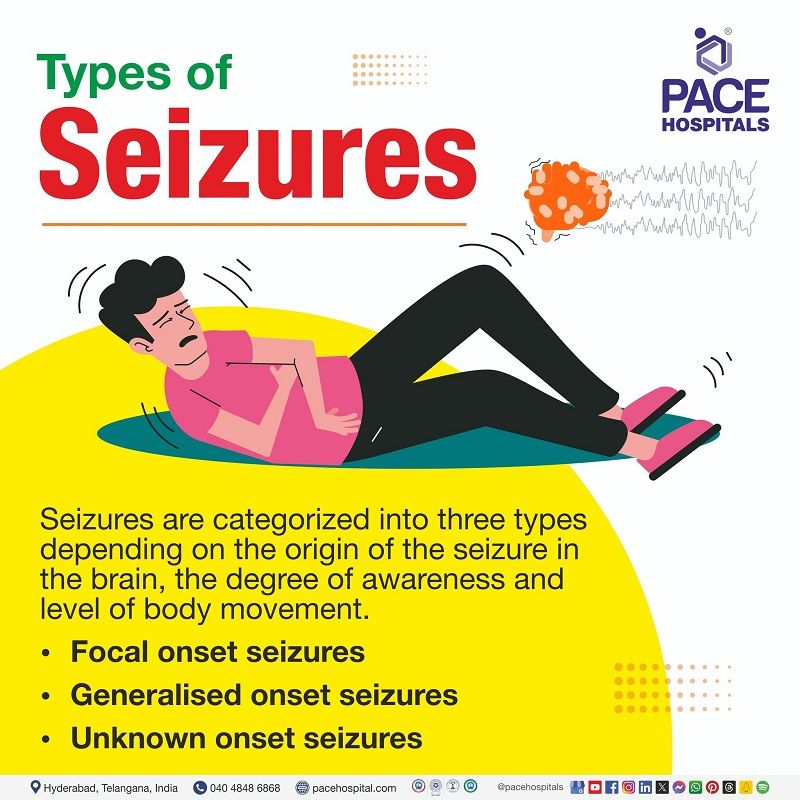
Types of seizures
The most recent International League Against Epilepsy (ILAE) classification of epileptic seizures and epilepsies (epilepsy syndromes), which was published in 2010, revises past classifications using new terminology and concepts that are suitable for the modern era. According to the International league against epilepsy (ILAE) revised classification.
Seizures are categorized based on 3 parameters:
- Origin of the seizure in the brain: Based on this, seizures can be either focal onset or generalized onset.
- The degree of awareness: during the seizure involves both awareness and impaired awareness.
- Level of body movement: Based on this, seizures can be either motor onset or non-motor onset, Therefore, seizures are classified into three types based on the above three features.
- Focal onset seizures, which are subsided into three subtypes:
- Retained awareness/impaired awareness
- Motor/non-motor onset
- Focal to bilateral tonic-clonic
- Generalized onset seizures consist of motor or non-motor (absence) onset seizures.
- Unknown onset seizures can be motor/non-motor or unclassified
Focal onset seizures
- A focal seizure may occur when the patient is fully conscious (aware of surroundings), known as the focal aware seizure. Nevertheless, in many cases, the patient is not aware of some things that happened during the seizure—this type of seizure is called focal impaired awareness.
- Focal seizures also previously called partial seizures.
- Partial seizures are the most frequent seizure type in adults.
- Jerking of a single limb (arm or leg) is seen in a focal seizure, and it can progress to involve both sides of the limbs (both arms and legs), where it is then called a focal to a bilateral tonic-clonic seizure.
Generalized onset seizures
Generalized onset seizures start in bilateral distributed neuronal networks. Generalized seizures occur by activating diffuse cortical at onset or generalizing partial seizure activity. Seizures can start in the cortex or subcortical structures. A seizure can begin to as a focal seizure and then become a generalized seizure. The generalized motor seizures include tonic-clonic, clonic, tonic, myoclonic, myoclonic-tonic-clonic, myoclonic-atonic, atonic, or epileptic spasms. In contrast, the non-motor symptoms are typical or atypical, with the absence seizures or seizures with myoclonic activity or eyelid myoclonia.
Seizures of unknown onset
These are seizures that occur either in sleep or in a condition that cannot be described as the patient is alone, and even the witness cannot describe the event.
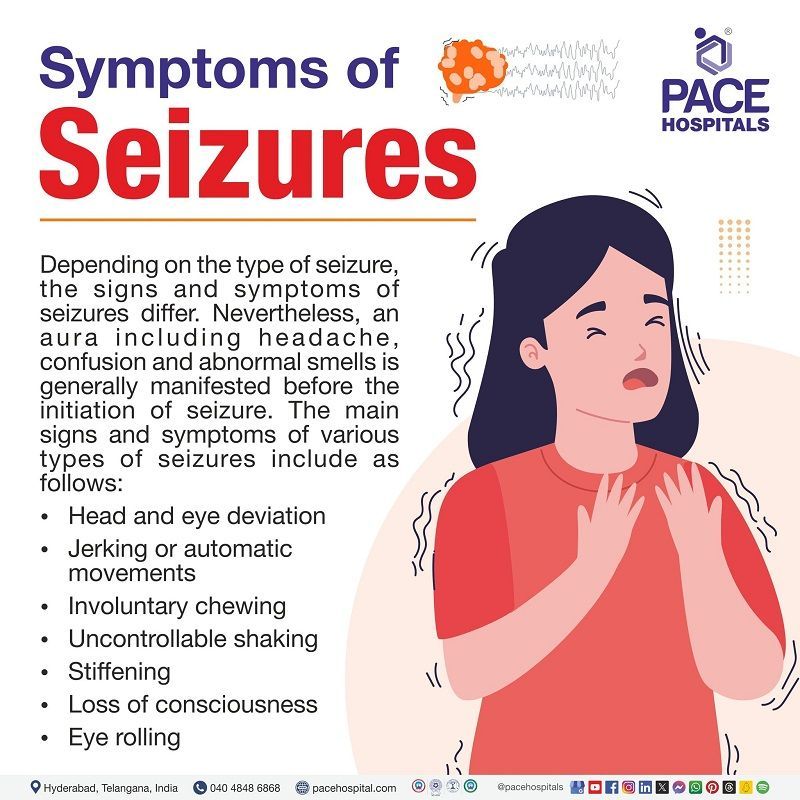
Seizure symptoms
Depending on the type of seizure, the signs and symptoms of seizures differ according to its type. Nevertheless, an aura is generally manifested before the initiation of seizure. Aura includes symptoms such as:
- Abnormal smells
- A sensation of fear
- An increase in the epigastric sensation
- Paraesthesia (sensation of tingling and numbness.).
In the postictal state (state that follows generalized onset seizures, which last from minutes to hours), the following are seen:
- Headache
- Confusion
- Deep sleep
- Muscle soreness
- Todd's paralysis (a transient neurologic deficit, usually weakness, of the limb opposite to the seizure focus)
The principle signs and symptoms of various types of seizures include:
- Focal aware seizure: Motor, sensory, or psychomotor symptoms can be seen.
- Focal impaired awareness seizures: Oral automatisms (involuntary chewing or lip-smacking); limb automatisms (e.g., automatic purposeless movements of the hands), irrelevant sounds. Head and eye deviation, usually in a direction opposite to the seizure focus. Bicycling or pedaling movements of the legs.
- Generalized seizures: Patients may or may not lose consciousness. Motor function is abnormal.
- Typical absence seizures: Duration of 0- to 30-second loss of consciousness with eyelid fluttering is seen. Axial muscle tone may or may not be lost.
- Atypical absence seizures: Jerking or automatic movements are more and last longer. Loss of awareness is less complete.
- Myoclonic absence seizures: Typically, these seizures last 10 to 60 seconds. The patient experiences the arms and shoulders jerking rhythmically (3 times/second), which causes progressive lifting of the arms. Impairment of consciousness may not be obvious.
- Eyelid myoclonia: The patient shows myoclonic jerks of the eyelids and eyes upward deviation.
- Atonic seizures: Include brief, complete loss of muscle tone and consciousness.
- Clonic seizures: The sustained rhythmic jerking occurs in the limbs of the body on both sides and often in the head, neck, face, and trunk.
- Myoclonic seizures: Brief, lightning-like jerks of a limb, several limbs, or the trunk, which may be repetitive, leading to a tonic-clonic seizure.
- Myoclonic-atonic seizures: The jerking of extremities or trunk briefly, then goes limp (drop attack).
- Absence seizure: Previously called petit mal seizures. People with absence seizures stare with unresponsiveness to external verbal stimuli, and sometimes they may have eyed blinking or head nodding symptoms.
- Generalized tonic-clonic seizure: Generalized tonic-clonic seizure, previously called grand mal seizure, involves bilateral symmetric convulsive movements (stiffening and then jerking) of all limbs with consciousness impairment.
- Febrile seizure: Uncontrollable shaking, Loss of consciousness, eye rolling, stiff limbs.
- Tonic clonic seizure: Jerks, body stiffening, shakes, loss of consciousness.
Some of the other types of seizures
- Febrile seizures: Febrile seizures occur when the child has a high fever due to illness. Generally, the febrile seizure treatment does not include any antiseizure medications unless there is any family history of epilepsy or if any nervous system impairment signs before the seizure or have a long or complicated seizure or more than one febrile seizure.
- Gyratory seizures: These types of seizures occur very rarely and usually have frontal and temporal seizure origins, as well as generalized epilepsies (grand mal seizure). When a gyratory seizure occurs, the patient involuntarily rotates around the body axis in a circular manner by at least 180 degrees or 360 degrees.
- Neonatal seizures: Neonatal seizures are a common neurological condition seen in neonates. Sudden, paroxysmal, abnormal alteration of electrographic activity can occur at any point from birth to the end of the neonatal period.
- Tonic seizure: Tonic seizures are sudden in onset and are characterized by a tonic extension of the trunk, head, and extremities that lasts for several seconds.
- Complex partial seizures: Complex partial seizures (CPSs), previously known as temporal lobe or psychomotor seizures, are among the most frequent types of seizures seen in both children and adults. Though CPSs commonly start in the temporal region, they may start elsewhere. The clinical manifestations(symptoms) may vary depending on the seizure onset.
- Breakthrough seizures: An epileptic seizure that occurs even after the usage of medications (antiepileptic drugs) that have otherwise successfully prevented seizures in the patient is known as a breakthrough seizure.
- Jacksonian seizure: A type of simple partial seizure with abnormal movements that starts in one group of muscles and progresses to adjacent groups of muscles is a Jacksonian seizure. In people with this type of seizure, seizures most likely result from lesions present in the cerebral cortex and subcortical white matter.
- Gelastic seizure: A rare form of epilepsy distinguished by inappropriate, uncontrolled laughter is termed a gelastic seizure. People with gelastic seizures are highly associated with abnormal cognitive development and behavioural problems.
- Psychogenic nonepileptic seizures: Psychogenic nonepileptic seizures (PNES), also termed pseudo seizures, are paroxysmal episodes that are similar and are often misdiagnosed as epileptic seizures; however, PNES are caused due to psychological conditions (i.e., emotional, stress-related)
- Refractory seizures: The usual brain electrical activity changes in refractory seizures, which may last for a few seconds or minutes. About one-third of individuals with epilepsy will eventually develop refractory epilepsy, and the wherein medications are ineffective or partially effective in controlling the seizures.
- Seizures during pregnancy: Seizures in pregnancy may occur in women who already have epilepsy. During pregnancy, most women will continue their previous level of seizure control, although 15-30% may experience an increase in seizures. Structural and metabolic changes may precipitate new-onset seizures during pregnancy.
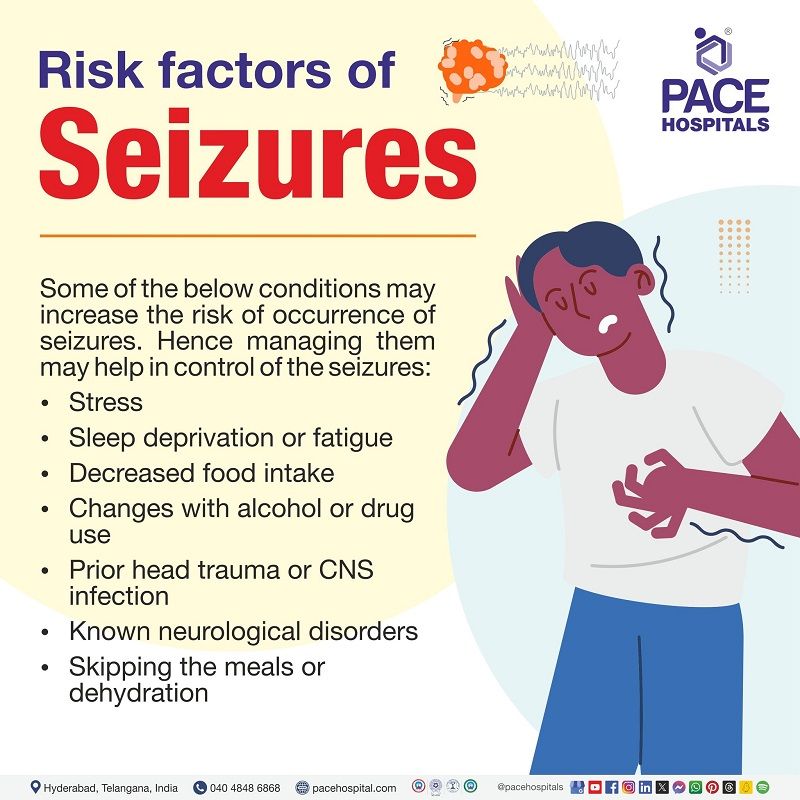
Seizure risk factors
Some of the below conditions can increase the risk of occurrence of seizures. The risk of injury related to seizure poses an important factor which the neurologist takes into consideration during treatment. Hence, managing the risk factors for seizure disorders may help in control of the seizures. The common risk factors for seizure disorders include:
- Stress
- Sleep deprivation or fatigue (feeling of tiredness)
- Decreased food intake.
- Alcohol use or withdrawal, or drug abuse
- Prior to head trauma or CNS infection
- Known neurological disorders.
- Skipping the meals or dehydration
- Skipping the prescribed anticonvulsant medications
- Hormonal changes associated with the menstrual cycle.
- Stimulation of vision such as flashing lights or moving pattern
- Poisons or toxins exposure like carbon monoxide and lead
- Family history of seizures
- Pregnancy
If there is a known brain injury or any other brain abnormality, then the person is twice as likely to have another seizure. If the patient does have 2 seizures, there is about an 80% chance of having more.

Reasons for seizures
Seizures are common in patients with systemic illness and may have many causes. They can be seen even in patients suffering from a non-neurological diagnosis who developed neurological complications.
Potential causes of seizures could be traced down to 4 divisions, which includes:
Organ failure:
- Multiple organ failure causes altered homeostasis (a self-regulating process that enables an organism to maintain internal stability while adjusting to changing external conditions).
- Electrolyte imbalances (changes in electrolyte levels like sodium, potassium, calcium etc. within the body fluid).
- Hypertensive encephalopathy (brain dysfunction that occurs when blood pressure is extremely high)
- Decreased blood concentrations of pro-convulsant medications due to reduced clearance (e.g., some antibiotics like carbapenems, macrolides).
- Brain tumours (The growth of abnormal cells in the tissues of the brain).
- Injury to the head
- Congenital disabilities (structural or functional anomalies that occur during intrauterine life).
- Stroke (a serious, life-threatening medical condition that happens when the blood supply to part of the brain is cut off).
- Bleeding in the brain
Postoperative:
- Anaesthesia related (by blocking of the sodium channels, seizure can occur in postoperative patients).
- Alcohol withdrawal (chemical changes in the brain of alcohol withdrawal patients can cause seizure).
Intensive care:
- Narcotic drugs withdrawal (opioids, cocaine)
- Sleep deprivation (Seizures are very sensitive to sleep pattern, thereby irregular sleep cycles can induce seizure).
- Emergency admissions
- HIV malaria infection (drugs used in the treatment of HIV may cause seizure) • Exposure to carbon monoxide toxins, etc.
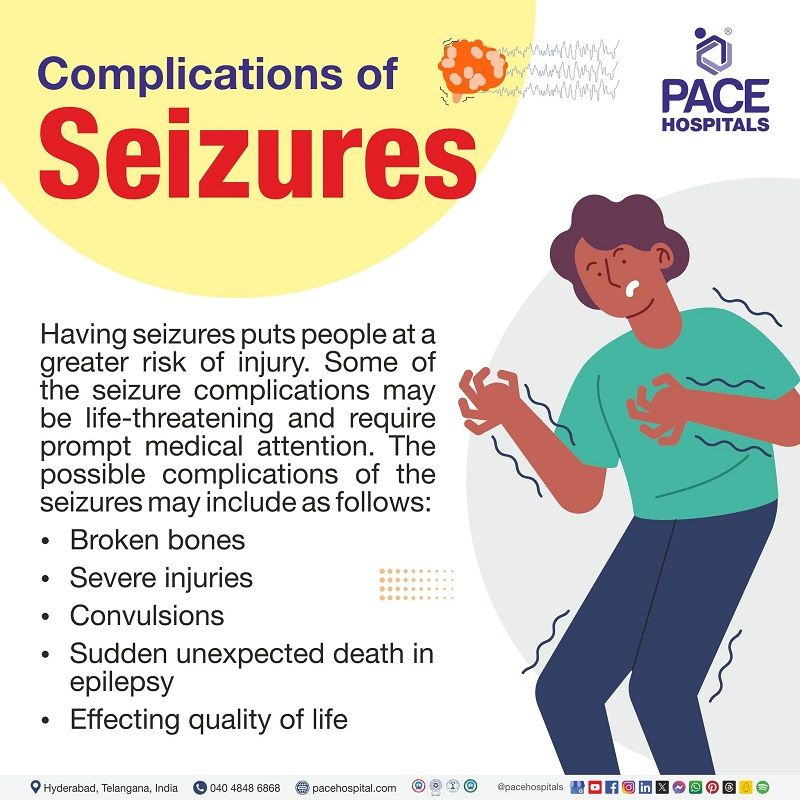
Complications of seizures
Having seizures puts people at a greater risk of injury. Some of the seizure complications may be life-threatening and require prompt medical attention. Below are the possible complications of seizure:
- Broken bones: Due to extreme, rapid muscle contractions.
- Severe injuries: Due to falls and accidents, accompanying by sudden loss of consciousness.
- Convulsions: Due to seizure recurrence. It also impairs intelligence.
- Sudden unexpected death in epilepsy: it is a significant complication, which usually occurs during sleep at night, has frequent seizures, and dies suddenly without a proper reason, mainly generalized tonic-clonic seizure.
- Effecting quality of life: A driving license is not issued to the uncontrolled seizure patient. They may face problems in their jobs or getting insurance. The quality of life may be decreased in such people.
Behavior after seizure (behavior changes after seizure in kids)
Children with chronic epilepsy demonstrated a risk of change in behavior (behavioral problems) 5 times higher than that of general population children. A 2011 study concluded that higher rates of behavior problems are seen in children suffering from new-onset seizures when compared to their healthy siblings.
The behavior problems are seemingly inconsistent in most children during their first three years, recovering from the seizure onset. With the onset of behavior problems in children, the neurologist may take the following family variables into consideration to handle their children’s behavior.
They include:
- Family satisfaction
- Parent support of child autonomy
- Parent confidence in handling children’s behavior.
Difference between seizure and convulsion
People often use convulsions and seizures interchangeably. However, they have different meanings. Not all seizures are characterized by convulsions. Convulsions involve uncontrollable shaking, and a seizure involves unusual movements. The other differentiating factors include:
| Parameter | Seizure | Convulsion |
|---|---|---|
| Meaning | A seizure involves an electrical disturbance in the brain | Convulsion involves involuntary and rhythmic muscle contractions and relaxations |
| Symptoms | Convulsions, altered consciousness, staring spells, unusual movements. | Jerking or shaking movements of the body. |
| Causes | Electrolyte imbalances, brain tumour, congenital brain defects, brain infections | Infection, head trauma, and some drugs |
| Appropriate tests | Electroencephalogram (EEG) | Medical history, blood tests |
Difference between Syncope and seizure
Both syncope and seizure cause loss of consciousness, but of different causes and treatments’ electroencephalogram (EEG) is the appropriate test to diagnose seizure. Determination of biomarker levels like creatine phosphokinase (CPK) Lactate dehydrogenase (LDH) and Neuronspecific enolase (NSE) can be a proper method for differential diagnosis of seizure and syncope. The results showed that serum NSE, CPK, and LDH levels increased in the seizure group when compared with syncope.
| Parameter | Syncope | Seizure |
|---|---|---|
| Meaning | Temporary loss of consciousness and inability to hold oneself upright. | Uncontrolled and atypical brain activity |
| Causes | Cardiac arrhythmias, reduced blood flow to the back of the brain, and low blood pressure. | Electrolyte imbalances, drug withdrawal, and fever brain infections, brain injury, and stroke. |
| Loss of consciousness | Present | May be present or absent |
| Appropriate diagnostic test | EEG (electroencephalogram) | Determination of Biomarker levels like NSE, CPK, and LDH |
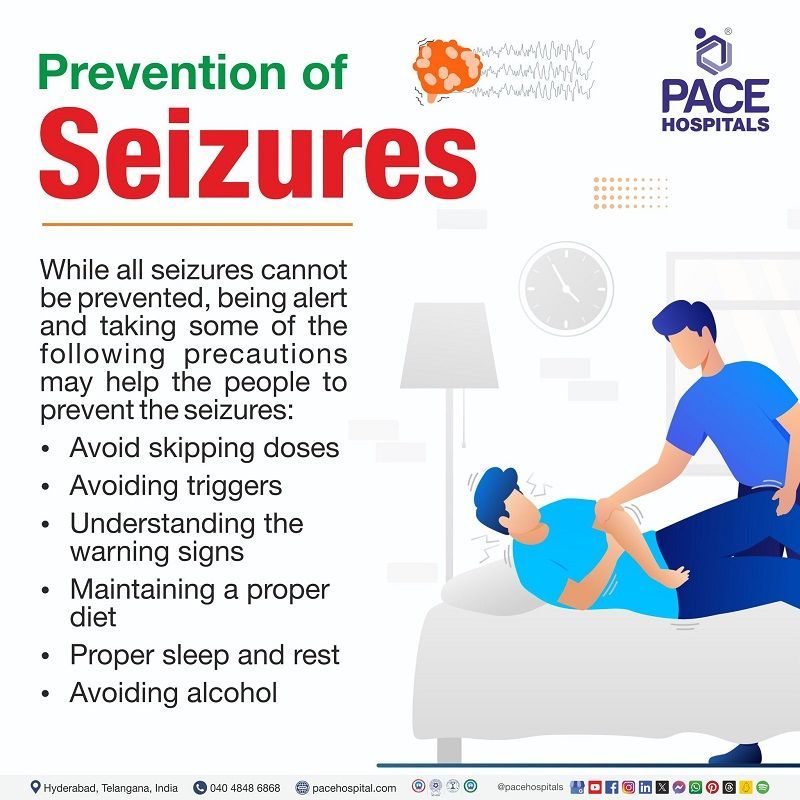
Seizures prevention
While all seizures cannot be prevented, being alert and taking some of these precautions helps people.
- Skipping doses: People already diagnosed with epilepsy or seizures should not skip the doses or stop the medication prescribed by the doctor.
- Avoiding triggers: Taking advice from the doctor regarding antiseizure medication and Avoiding stress-related activities as they trigger seizures.
- Warning signs of a seizure: Before the seizure, people may see the aura as a warning sign, change in taste, change in body temperature, or vision problems may happen; hence, people need to get alert and move to a safe place where others are available for help.
- Guiding people to a safe place: Pupils' sizes may be changed, and people may look different and out of character. Then, moving to a safe place should be guided to such people.
- Seizure diet: It is a ketogenic diet, consisting of high fat and protein and very low in carbohydrates; taking it according to the advice of a physician may help reduce seizure occurrence.
- Proper sleep and rest: can reduce the number of seizures. Lacking them triggers seizures.
- Avoiding alcohol.
Seizure diagnosis
Clinical evaluation of the patient is the most common diagnostic aspect to understand a seizure attack. The other nursing diagnosis for seizures includes:
- Blood tests like (serum electrolytes, blood urea nitrogen (BUN), creatinine, glucose, calcium(ca), magnesium, and phosphate levels), and liver function tests.
- Electroencephalogram (EEG)
- Antiseizure drug levels are checked in patients who are already diagnosed with seizure and are using antiseizure drugs.
- Computed tomography (CT) scan
- Magnetic resonance imaging (MRI) scan
- Lumbar puncture in meningitis or central nervous system infection patients with normal neuroimaging results.
- Functional magnetic resonance imaging (MRI) Magnetoencephalography with EEG (magnetic source imaging)
- Single-photon emission computed tomography (SPECT)
Seizure treatment
Seizure management includes the following:
Medical management of seizure
- Usually antiseizure drugs (seizure medications) are required, but only after a second seizure, because usage of antiseizure drugs, particularly in children, causes learning problems or behavioral changes.
- Some of the seizures require seizure medications according to their type; single drugs do not control the seizures.
- Different patients may need other multiple antiseizure medications like succinimide, benzodiazepines, iminostilbenes are generally prescribed to the seizure patients.
Surgical management of seizure
If the patient fails to control the seizure using more than two seizure drugs in therapeutic doses, surgery is recommended. Nearly 10 to 20% of patients fail medical treatment.
- Conventional epilepsy surgery: (surgical removal of a part of the epileptic focus). The patients not fit for the surgery are additionally treated by vagus nerve stimulation, in which the left vagus nerve is stimulated by placing a vagus nerve stimulator.
- Brain-responsive neurostimulation: Another option to treat patients who are not suitable for the surgery.
FAQs - Frequently asked questions
-
What is a seizure?
A seizure is a quick abnormal electrical activity in the brain that can cause shortchanges (temporary) in feelings, behaviour, and movements like jerking arms and legs and sudden stiffening with awareness or awareness impairment.
-
Are epilepsy and seizures the same?
No, epilepsy and seizures are not exact. Epilepsy is a brain disorder associated with repetitive seizures, whereas a seizure is a quick abnormal brain electrical activity that can cause shortchanges (temporary) in behavior and feelings.
-
What to do during a seizure?
Staying along with the person and keeping them safe, protecting them from injury by removing the sharp objects near them, loosening the clothes near the neck, placing something soft under their head and rolling them on the left side to prevent aspiration can be done during a seizure.
-
Can seizures cause death?
Yes, seizure can cause death, but it is very uncommon. A condition -Sudden Unexpected Death in Epilepsy (SUDEP) causes deaths in people with epilepsy that are not from injury, drowning, or other known causes. The exact cause is unknown, but possible factors are difficulty breathing (sleep apnoea) and abnormal heart rhythm.
-
What causes seizures in newborn babies?
Preterm birth, fetal distress, maternal diabetes, including hypoxic-ischemic brain injury and hypoglycaemia (low sugar levels), maternal hypothyroidism (underactive thyroid gland during pregnancy) diagnosed after birth, genetic factors, positive family history, and a 5-min Apgar (rapid assessment of a newborn given at five minutes after birth) score may cause seizures in newborn babies.
What causes seizure?
The causes of seizures are multifactorial. Seizures can be caused in epilepsy, brain bleeds or stroke, when there is any injury to the head or if any brain infections, congenital disabilities or any birth trauma, Genetic factors, taking some illicit drugs, brain tumours.
How to prevent seizures?
Seizures can be prevented by taking a proper ketogenic diet, proper medication, and by avoiding skipping prescribed doses and by, having adequate sleep, exercise, and avoiding alcohol, illicit drugs, and stress-related activities.
What causes seizures in adults with no history?
A seizure occurs when the standard connection between the nerve cells in the brain is disturbed. Alcohol or drug withdrawal, high fever, and abnormal blood sugar levels may be the causes of the seizure.
Can stress cause seizures?
Yes, stress can be a cause for a seizure. Having stress can decrease sleep, increase specific hormones that affect the brain, and create mood problems like depression and anxiety, which in turn increase the chance of seizures.
What to do if a pregnant woman has a seizure?
Pregnant women need to take advice from the doctor regarding balancing the risks of using antiseizure medication with the risk of having seizures. Doctors may prescribe a high dose of folic acid supplement every day to reduce the risk of congenital disabilities in the baby.
What happens if absence seizures go untreated?
If absence seizures are not treated, they may worsen over time and cause brief but frequent lapses of consciousness, which affects learning, development, behavior, and concentration problems in some children.
What is a tonic-clonic seizure?
Tonic-clonic seizures involve stiffening (tonic) and jerking or twitching (clonic) phases of muscle activity. They may start with an aura and experience behavior, mood, sensations, smell, and taste changes.
What is a partial seizure?
A partial seizure is an episode of involuntary movement that may start in neuronal networks restricted to only one cerebral hemisphere part., in which one area of the cortex activates first and may have simple symptoms like motor or sensory phenomena.it is also called a focal seizure.
Can a blood test detect a seizure?
Yes, the blood test, done within 10–20 minutes after a seizure, may identify the generalized tonicclonic and complex partial type of seizures in adults and some older children. The level of prolactin in the blood increases after these seizures occur.
Department of Neurology
Request an appointment
Fill in the appointment form or call us instantly to book a confirmed appointment with our super specialist at 04048486868
Appointment request - health articles
Thank you for contacting us. We will get back to you as soon as possible. Kindly save these contact details in your contacts to receive calls and messages:-
Appointment Desk: 04048486868
Whatsapp: 8977889778
Regards,
Pace Hospitals
Hitech City and Madinaguda
Hyderabad, Telangana, India.
Oops, there was an error sending your message. Please try again later. We will get back to you as soon as possible. Kindly save these contact details in your contacts to receive calls and messages:-
Appointment Desk: 04048486868
Whatsapp: 8977889778
Regards,
Pace Hospitals
Hitech City and Madinaguda
Hyderabad, Telangana, India.
Our Locations
Subscribe to our newsletter and stay updated with the latest health information.
By clicking on subscribe now, you accept to receive communications from PACE Hospitals on email, SMS and Whatsapp.
Subscribe to PACE Hospitals News
Thank you for subscribing. Stay updated with the latest health information.
Oops, there was an error. Please try again submitting your details.
-

Payment in advance for treatment (Pay in Indian Rupees)
For Bank Transfer:-
Bank Name: HDFC
Company Name: Pace Hospitals
A/c No.50200028705218
IFSC Code: HDFC0000545
Bank Name: STATE BANK OF INDIA
Company Name: Pace Hospitals
A/c No.62206858997
IFSC Code: SBIN0020299
Scan QR Code by Any Payment App (GPay, Paytm, Phonepe, BHIM, Bank Apps, Amazon, Airtel, Truecaller, Idea, Whatsapp etc)
Call us at 04048486868
ADDRESS
PACE Hospitals
Hitech City : Beside Avasa Hotel, Pillar No. 18, Hyderabad - 500081
Madinaguda: Mythri Nagar, Beside South India Shopping, Madinaguda, Hyderabad - 500050
QUICK LINKS
Disclaimer
General information on healthcare issues is made available by PACE Hospitals through this website (www.pacehospital.com), as well as its other websites and branded social media pages. The text, videos, illustrations, photographs, quoted information, and other materials found on these websites (here by collectively referred to as "Content") are offered for informational purposes only and is neither exhaustive nor complete. Prior to forming a decision in regard to your health, consult your doctor or any another healthcare professional. PACE Hospitals does not have an obligation to update or modify the "Content" or to explain or resolve any inconsistencies therein.
The "Content" from the website of PACE Hospitals or from its branded social media pages might include any adult explicit "Content" which is deemed exclusively medical or health-related and not otherwise. Publishing material or making references to specific sources, such as to any particular therapies, goods, drugs, practises, doctors, nurses, other healthcare professionals, diagnoses or procedures is done purely for informational purposes and does not reflect any endorsement by PACE Hospitals as such.

